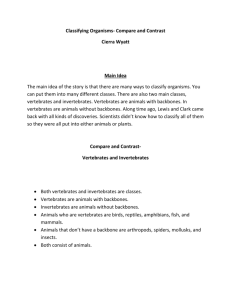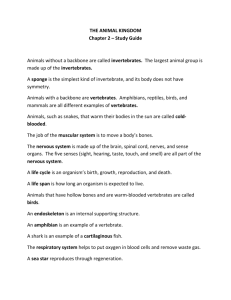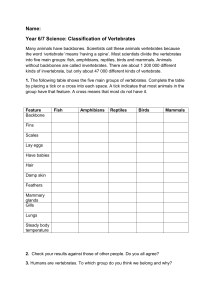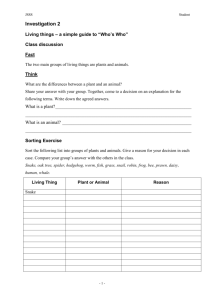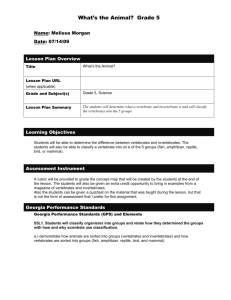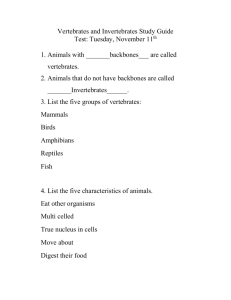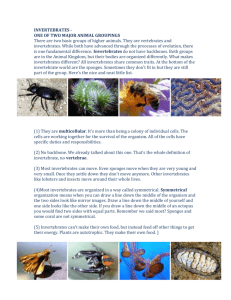6-3.1 - S2TEM Centers SC
advertisement
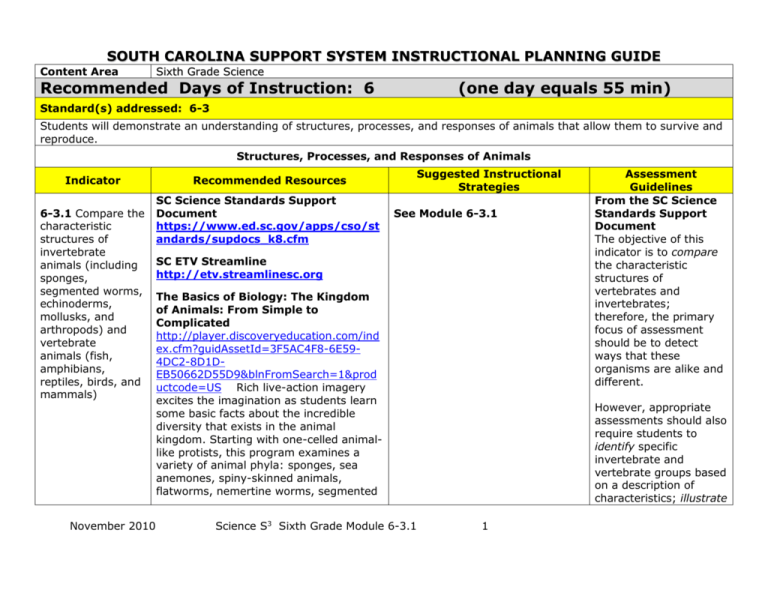
SOUTH CAROLINA SUPPORT SYSTEM INSTRUCTIONAL PLANNING GUIDE Content Area Sixth Grade Science Recommended Days of Instruction: 6 (one day equals 55 min) Standard(s) addressed: 6-3 Students will demonstrate an understanding of structures, processes, and responses of animals that allow them to survive and reproduce. Structures, Processes, and Responses of Animals Indicator 6-3.1 Compare the characteristic structures of invertebrate animals (including sponges, segmented worms, echinoderms, mollusks, and arthropods) and vertebrate animals (fish, amphibians, reptiles, birds, and mammals) November 2010 Recommended Resources SC Science Standards Support Document https://www.ed.sc.gov/apps/cso/st andards/supdocs_k8.cfm Suggested Instructional Strategies See Module 6-3.1 SC ETV Streamline http://etv.streamlinesc.org The Basics of Biology: The Kingdom of Animals: From Simple to Complicated http://player.discoveryeducation.com/ind ex.cfm?guidAssetId=3F5AC4F8-6E594DC2-8D1DEB50662D55D9&blnFromSearch=1&prod uctcode=US Rich live-action imagery excites the imagination as students learn some basic facts about the incredible diversity that exists in the animal kingdom. Starting with one-celled animallike protists, this program examines a variety of animal phyla: sponges, sea anemones, spiny-skinned animals, flatworms, nemertine worms, segmented Science S3 Sixth Grade Module 6-3.1 Assessment Guidelines From the SC Science Standards Support Document The objective of this indicator is to compare the characteristic structures of vertebrates and invertebrates; therefore, the primary focus of assessment should be to detect ways that these organisms are alike and different. However, appropriate assessments should also require students to identify specific invertebrate and vertebrate groups based on a description of characteristics; illustrate 1 worms, mollusks, arthropods, and vertebrates. the different kinds of vertebrates and invertebrates by their distinctive differences; or classify an animal into a particular group based on its characteristics. Classification of Living Things http://player.discoveryeducation.com/ind ex.cfm?guidAssetId=902F8724-B78E4E18-9D24A5E6B4D743B4&blnFromSearch=1&produ ctcode=US A routine castle tour turns enchanting when King Philip shows up to teach a lesson in classification. Using examples from his castle, mnemonics for memorizing the 7 levels of classification, microscopic footage, and animation, King Philip makes sense of difficult concepts. From simple examples to an exploration of each of the five kingdoms, this tour provides a concrete foundation for a complex subject. Biology: The Science of Life: The World of Living Things http://player.discoveryeducation.com/ind ex.cfm?guidAssetId=6032AC40-C8D14706-964D32B392639BF5&blnFromSearch=1&produ ctcode=US This fifteen-minute program introduces students to biology: the science of life. Nine important characteristics of living things are presented. The characteristics used for classifying living things into one of five basic kingdoms (Monera, Protista, Fungi, Animalia, and Plantae) are also presented in this informative video. November 2010 Science S3 Sixth Grade Module 6-3.1 2 Animals with Backbones: The Vertebrate Story: The Mammal Story http://player.discoveryeducation.com/ind ex.cfm?guidAssetId=221EFDC2-C70A4570-B57C2D3A8A51BFF4&blnFromSearch=1&produ ctcode=US Mammals, the fifth and most complex vertebrate group, have characteristics that no other vertebrates share. Mammals have succeeded in the widest variety of earth’s habitats because of their advanced adaptations, which even include a way of producing offspring that no other group of animals has developed. We explore the grouping of mammals by their adaptations, dietary preferences, and the benefits humans have enjoyed through domestication of certain mammals. A short video quiz follows the program. Animals With Backbones: The Vertebrate Story: Reptiles and Birds http://player.discoveryeducation.com/ind ex.cfm?guidAssetId=9C36811E-7EB94ED8-A97D97358766C99B&blnFromSearch=1&produ ctcode=US Join Dr. Brian Jerome as he follows scientists tracking one of North America's most dangerous reptiles: the timber rattlesnake. The video then explores the three major reptile groups: snakes and lizards, turtles, and alligators and crocodiles, and some of their adaptations. Part Two of the November 2010 Science S3 Sixth Grade Module 6-3.1 3 video covers warm-blooded, egg-laying, feathered vertebrates and their adaptations. Birds from all over the world, including our backyards, serve as examples. Two video quizzes are included. Animals Without Backbones: The Invertebrate Story http://player.discoveryeducation.com/ind ex.cfm?guidAssetId=8AA2C495-5095493A-873FBD1D66B9579C&blnFromSearch=1&prod uctcode=US Come along on an expedition with Dr. Brian Jerome as he visits such exciting locations as the Everglades, coral reefs, Okeefenokee Swamp, Atlantic beaches, coastal marshes and the Great Smoky Mountains in search of invertebrates. Animals with Backbones: The Vertebrate Story: Fish and Amphibians http://player.discoveryeducation.com/ind ex.cfm?guidAssetId=24A7F676-DB2749D3-A9714A88D4A9B27C&blnFromSearch=1&prod uctcode=US As different as fish and amphibians are from each other, they have some physical characteristics in common and even share characteristics with other animals such as snakes, birds, and humans. This lesson offers a straightforward examination of November 2010 Science S3 Sixth Grade Module 6-3.1 4 the various groups of vertebrates, or animals with backbones. Fish and amphibians, the first two groups of vertebrates, are the main focus of the program. Short video quizzes complete both the fish and amphibian segments. Animal Characteristics http://www.kidport.com/RefLib/Science/A nimals/Animals.htm This website compares the structures of vertebrate and invertebrate animals. Pictures of vertebrates and invertebrates. Animal Diversity Web http://animaldiversity.ummz.umich.edu/s ite/index.html This website provides information on animal history, classification, sounds, and pictures. Vertebrate Flip Chart www.prometheanplanet.com Vertebrates and Invertebrates (Assessment included) http://www.prometheanplanet.com/ All about mammals. Promethean Planet. http://www.prometheanplanet.com/serve r.php?show=ConResource.11945 November 2010 Science S3 Sixth Grade Module 6-3.1 5 Sixth Grade Science Module 6-3.1 Structures, Processes, and Responses of Animals Lesson A-C Standard 6-3: Students will demonstrate an understanding of structures, processes, and responses of animals that allow them to survive and reproduce. Indicator 6-3.1: Compare the characteristic structures of invertebrate animals (including sponges, segmented worms, echinoderms, mollusks, and arthropods) and vertebrate animals (fish, amphibians, reptiles, birds, and mammals) Other indicators addressed: 6-1.3 Classify organisms, objects, and materials according to their physical characteristics by using a dichotomous key. November 2010 Science S3 Sixth Grade Module 6-3.1 6 From the South Carolina Support Documents: Indicator 6.3.1: Compare the characteristic structures of invertebrate animals (including sponges, segmented worms, echinoderms, mollusks, and arthropods) and vertebrate animals (fish, amphibians, reptiles, birds, and mammals). Taxonomy level: Understand Conceptual Knowledge (2.6-B) Previous/Future knowledge: Students have previously studied animals in 2nd grade, 3rd grade, and 4th grade. In 4th grade (4-2.1), students studied specific vertebrate animal groups and their characteristics but not specific invertebrate animal groups. Students will focus on the study of the human body in 7th grade. It is essential for students to know that the Animal Kingdom is divided into 35 different phyla. These phyla can be classified into two groups (vertebrates or invertebrates) based on external and internal physical characteristics. However, all animals share several common characteristics: o Their bodies are multi-cellular. o They are heterotrophs (cannot make their own food) and must get their energy by eating plants or other animals. o Their major functions are to obtain food and oxygen for energy, keep their internal conditions in balance, move, and reproduce. o Vertebrates comprise only one phylum of animals. They include fish, amphibians, reptiles, birds, and mammals. Vertebrates share certain physical characteristics: They have backbones, an internal skeleton (endoskeleton), and muscles. They have blood that circulates through blood vessels and lungs (or gills) for breathing. They have a protective skin covering. Most have legs, wings, or fins for movement. They have a nervous system with a brain that processes information from their environment through sensory organs. Vertebrates differ in the way that they control their body temperature. In some (fishes, amphibians, and reptiles), their body temperature is close to that of their environment. They are considered cold-blooded, or ectothermic. In others (birds and mammals), their body temperature stays constant regardless of the temperature of the environment. They are called warmblooded, or endothermic. Examples of vertebrates include: Fish Are cold-blooded (ectothermic); obtain dissolved oxygen in water through gills; most lay eggs; have scales; have fins; and live in water. November 2010 Science S3 Sixth Grade Module 6-3.1 7 Amphibians Are cold-blooded (ectothermic); most can breathe in water with gills as young, and breathe on land with lungs as adults; go through metamorphosis; lay jelly-like eggs. The major groups of amphibians are frogs, toads, and salamanders. Frogs and salamanders have smooth, moist skin, through which they can breathe and live part of their life in water and part on land. Toads have thicker, bumpy skin and live on land. Reptiles Are cold-blooded (ectothermic); breathe with lungs; most lay eggs, although in some the eggs hatch inside the female; and have scales or plates. Birds Are warm-blooded (endothermic); breathe with lungs; lay eggs; have feathers; and have a beak, two wings, and two feet. Mammals Are warm-blooded (endothermic); breathe with lungs; most have babies that are born live; have fur or hair; and produce milk to feed their young. Invertebrates comprise the remaining phyla of the Animal Kingdom. They include sponges, segmented worms, echinoderms, mollusks, and arthropods. Invertebrates share certain characteristics: They do not have backbones or internal skeletons. Some have external skeletons, called exoskeletons. Examples of invertebrates include: Sponges Very simple animals that have many pores (holes) through which water flows. Water moves into a central cavity and out through a hole in the top. Sponges obtain their food and eliminate wastes through this passage of water. They have specialized cells for obtaining food and oxygen from the water. Segmented worms Have long tube-like bodies that are divided into segments. They are the simplest organisms with a true nervous system and blood contained in vessels. A long digestive tube runs down the length of the worm’s inner body. Worms take in dissolved oxygen from the water through their skin. Examples of segmented worms may be earthworms and leeches. November 2010 Science S3 Sixth Grade Module 6-3.1 8 Echinoderms Have arms that extend from the middle body outwards. They have tube feet that take in oxygen from the water and spines. Examples may be sea stars, brittle stars, sea cucumbers, or sea urchins. Mollusks Have soft bodies; most have a thick muscular foot for movement or to open and close their shells. They have more developed body systems than sponges or worms. They take in oxygen through gills or lungs, and some have shells. Examples may be slugs, snails, clams, and octopuses. Arthropods Have jointed legs, segmented bodies, and some have wings. They have hard outer coverings called exoskeletons. They obtain oxygen from the air through gills or air tubes. Examples may be insects, arachnids, and crustaceans. It is not necessary for students to know the classification systems for the vertebrates and invertebrates, life cycles of the various animal groups, other types of worms, other groups of invertebrates, or the major organs, systems or complete anatomy of each group of animals. Assessment Guidelines: The objective of this indicator is to compare the characteristic structures of vertebrates and invertebrates; therefore, the primary focus of assessment should be to detect ways that these organisms are alike and different. However, appropriate assessments should also require students to identify specific invertebrate and vertebrate groups based on a description of characteristics; illustrate the different kinds of vertebrates and invertebrates by their distinctive differences; or classify an animal into a particular group based on its characteristics. November 2010 Science S3 Sixth Grade Module 6-3.1 9 Teaching Indicator 6-3.1: Lesson A - Classification of Vertebrates and Invertebrates Instructional Considerations: This lesson is an example of how a teacher might address the intent of this indicator. FOSS Diversity of Life kit provides an opportunity for conceptual development of the concepts within the standard. If you have already studied plants, students have been involved in several lessons on classification. (Indicator Module 6-2) You may want to review those lessons at this time. If not, you will want to make sure your review classification by having students classify classroom objects. You will also want to make sure to use the Inquiry Indicator 6.1.3 lesson on Dichotomous keys during this module. At the end of the module, students should be able to describe the difference between vertebrate and invertebrate animals, describe the characteristics of the different phyla of vertebrates and invertebrates and identify vertebrates which are warmblooded and those which are cold-blooded. Preparation for the Lesson: Obtain materials Prepare or gather animal cards Misconceptions: At the elementary level students tend to classify animals using characteristics such as movement, number of legs, body covering and habitat. This often leads students to classify animals incorrectly. One example of this is classifying whales as fish. In the primary grades, students classify animals based on whether they fly or live in water. Upper elementary students use observable features and concepts for classification into groups. By middle school students are able to use a hierarchical system of classification. Often students have a hard time believing that insects are animals due to the fact that they have studied them separate from other animal groups. Make sure all units are related and tied back to the larger grouping of animals. Safety Note: Safety must be emphasized at the beginning of the school year and reinforced with every lab activity. Students should understand that safety is everyone’s responsibility. Lesson time: 2 days (1 day equals 55 minutes) Materials Needed: (per pair) 1. Pictures of various vertebrates and invertebrates 2. Sheet of 8 1/2 x 11 paper for each student November 2010 Science S3 Sixth Grade Module 6-3.1 10 Focus Questions: How can you develop a classification system for animals? Why are the common characteristics of all vertebrates and invertebrates? Engage: 1. Provide a sheet of 81/2 x 11 paper for each student. 2. Tell them to fold the paper in half vertically (hot dog fold). 3. Tell them that they are going to have two minutes to write down on the left hand side of their folded paper all the animals they can think of. (Note: They can be as specific as they want to be…using terms like bug or ladybug). 4. Check with them after two minutes and allow more time if needed. 5. Pair them with a partner and have the partners share their list and add additional animals to their list. 6. Ask students to share with the class any animals they think others may not have thought of. 7. Ask students to suggest the characteristics they used to name the animals. 8. Scribe their responses. 9. Tell students that you are going to use this list to begin to learn about the characteristics of animals that allows us to classify them into vertebrates and invertebrates, the two phyla of animals. 10.Make sure they keep this list for reference later in Lesson A and in Lesson B that follows. Explore: 1. Ask students to examine their list and think about how they could classify or sort their list of animals. Take suggestions. (Answers might include whether they live on land, in the water, fly, walk, etc.) 2. Tell students that they are being asked to sort them into only two groups. Ask them to suggest categories for those two groups. 3. Tell them that scientists classify all animals into two phyla (groups). Ask if anyone knows what characteristic is used by scientists for this classification. (Teacher note: If you have completed the plants modules, they should be familiar with the term phyla. If not, you may need to share the Linnaean classification system with them first). 4. Share the two phyla scientists use for classifying animals: vertebrate and invertebrates. Write these two terms on the board and ask them to infer from these terms the characteristic that scientist use for this classification. 5. Show the class a few pictures of vertebrates (fish, reptiles, etc) and invertebrates (mollusks, sponges, etc). Ask them to identify those that are vertebrates and those that are invertebrates. 6. Ask the students to return to their brainstormed list and classify their animals as vertebrates and invertebrates by writing the name of any invertebrates in a list to the right of the fold. 7. Class share out: What are some of your examples of vertebrates? Invertebrates? How do your lists compare in number? November 2010 Science S3 Sixth Grade Module 6-3.1 11 8. Divide the students into pairs and give each pair a set of cards with different vertebrates and invertebrates. Ask each group to classify the cards into two groups (vertebrates and invertebrates). 9. Discuss the attributes they used to group the organisms as vertebrates or invertebrates. 10.Explain/Remind them that a dichotomous key is a tool used by scientists to classify organisms and other objects by observable properties and attributes. 11.Ask the students to share out the animals in each group. List these on the board or a piece of chart paper in two groupings, leaving room below to list other groupings. This will be the beginnings of a Tree Diagram. 12.Have students continue to use observable features to subdivide each group based on different attributes. For example students will begin with two groups: Vertebrates and Invertebrates. Then they will separate the vertebrates into groups based on like attributes and Invertebrates into groups based on like attributes. Under Vertebrates, they might have a grouping of pictures of birds, one of reptiles, etc. Under invertebrates, a group with mollusks, another with sponges, etc. It is not necessary at this time that they can tell all the characteristics or name each of the groups. 13.Ask different groups of students to share their groupings and record these on the chart paper/board. As they share clarify characteristics they used and listen for misconceptions. 14.Allow students time to reproduce their classification by drawing a “tree” diagram and adding the names of the animals and the attributes used. This can be done in their notebooks. 15.If you have not used Inquiry Indicator lesson 6.1.3 on classification do so now. Explain: 1. Have students share their “tree” for the animal cards. 2. Ask them to explain reasons for their groupings. a. How are your two groups alike? How are they different? 3. Remind them that these two groups are the two phyla of the animal kingdom. (vertebrates and invertebrates) Ask them? Why do scientists use classification systems? 4. Ask them to describe some of the attributes that they used for classifying vertebrates and invertebrates into smaller groups. (Use the support document information as needed.) 5. Have students return to their original list of animals, label the left side vertebrates and the right invertebrates and add the characteristics of vertebrates and invertebrates to each side. Allow time for them to use these characteristics/attributes and make changes to their list as needed. 6. Exit Slip: Name the two phyla of the animal kingdom and give 2 examples of each group. November 2010 Science S3 Sixth Grade Module 6-3.1 12 Extend: 1. Use Vertebrate Flip Chart from www.prometheanplanet.com if available 2. Harward, D. (2007). Vertebrates and Invertebrates (Assessment included). http://www.prometheanplanet.com/ 3. The Basics of Biology: The kingdom of animals: From simple to complicated. See resources. 4. Classification of living things. See Resources 5. Biology: The science of life: The world of living things. See Resources. November 2010 Science S3 Sixth Grade Module 6-3.1 13 Teaching Indicator 6-3.1: Lesson B - Ectothermic or Endothermic Vertebrate Animals Instructional Considerations: This lesson is an example of how a teacher might address the intent of this indicator. FOSS kit Diversity of Life provides an opportunity for conceptual development of the concepts within the standards. In lesson A, students explored the two groups of animals by classifying them and constructing a dichotomous key. In Lesson B, students will explore vertebrate animals in more depth as they classify vertebrates into classes and then explore the characteristics of ectothermic and endothermic vertebrates. Students will need the brainstormed list from Lesson A. Lesson C will allow them to explore the definitions of ectothermic and endothermic as they carry out an investigation with Goldfish. Preparation for the Lesson: Gather Picture cards for vertebrate animals (Lesson B cards plus others needed for complete set representing each class of vertebrates) Secure resources (books, internet access, etc.) of vertebrate animals Create color-coding charts for use by students or make a large poster for the front of the room (blue=fish, green=reptiles, purple=amphibians, red=birds, orange=mammals) Misconceptions: Elementary- and middle-school students hold a much more restricted meaning than biologists for the word "animal". For example, most students list only vertebrates as animals. Elementary- and middle-school students use such criteria as number of legs, body covering, and habitat to decide whether things are animals. http://strandmaps.nsdl.org/?id=SMS-MAP-2105 Safety Note: Safety must be emphasized at the beginning of the school year and reinforced with every lab activity. Students should understand that safety is everyone’s responsibility. Lesson Time: 3 days (1 day equals 55 minutes) Materials Needed Books and pictures of vertebrate animals Vertebrate Picture Cards (Set for each cooperative group) Color coded chart (see above) Colored pencils or crayons (1 set per group) Index cards (5 per student) Poster paper, newsprint or chart paper “white boards” (white paper inside of plastic sheet) Washable markers November 2010 Science S3 Sixth Grade Module 6-3.1 14 Focus Question: What are the characteristics of the five groups of vertebrates? Engage: 1. Post coding chart for easy viewing by all students. 2. Ask students to take out their brainstormed list of animals from Lesson A. 3. Tell students that today they are going to look at vertebrates more closely as they classify the vertebrates on their brainstormed list from Lesson A’s and examine the difference between ectothermic and endothermic vertebrates. 4. Make sure student groups have colored pencils or crayons. 5. Tell students they are to use the color coded chart to circle or underline each vertebrate animal in their brainstormed list based on the type of animal it is (fish, reptile, etc.) 6. Tell them that after they have had time to classify all of their vertebrates you will discuss the characteristics they used. 7. If they are unsure about how to classify an animal on their list, they may either put a check mark by it and return later or discuss it with other members of their group. 8. Encourage discussions among groups. Circulate to listen for and clarify misconceptions. 9. Ask students how many animals they have in each classification. Ask them if they need clarification on any animals they did not classify? Ask them if there are any animals they would move to the invertebrate side of their list now. 10.Tell them that even though 99% of all animal species are invertebrates that commonly in a list of animals, there will be more vertebrates than invertebrates listed. Explore: 1. Tell students that in Lesson A and this one as well they’ve been looking at how scientists use characteristics of attributes of animals to classify them. 2. Write the words ectothermic and endothermic on the board. 3. Ask students to use the root word in each word and infer the attribute it refers to. (therm for temperature…) 4. Ask them to use the prefix and infer the meaning of the word. (ecto—outer; endo—inner) 5. Explain that these terms describe one of the attributes scientists use for classifying invertebrates (whether they are cold-blooded --ectothermic— body temperature is close to that of the environment) or (warm-bloodedendothermic--body temperature stays constant regardless of the environment). 6. Ask each student to select one of the vertebrates from their list and use their notebooks to draw a picture of that animal’s environment. Based on the environment, ask them to provide evidence for whether their animal is ectothermic or endothermic. November 2010 Science S3 Sixth Grade Module 6-3.1 15 7. Divide the class into collaborative groups of 5. Distribute the vertebrate cards randomly so that all classes of vertebrates are represented in each group. Each person will be responsible for researching an animal from one of the groups/classes of vertebrates (fish, reptiles, birds, amphibians and mammals). 8. Provide resources and time for each student to thoroughly research his/her animal. 9. Product: a poster containing name, classification, characteristics and any other information about the environment. Should also include an illustration of the animal and its environment. Students will present these to the other members of their group. 10. Before group presentation, regroups students into like groups (all who researched fish together, etc. 11. Allow time for them to share their research and add or change any information. 12. All students return to original groups. 13. Give each student 5 index cards. 14. Have each student label the cards, one label per card: fish, reptiles, amphibians, birds, and mammals. 15. Have students present their posters to members of their collaborative group. As they present, other students will listen and record characteristics on the appropriate cards. Explain: 1. Ask students to return to their original brainstormed list and classification chart of vertebrate and invertebrate cards and re-sort if necessary then make sure class of vertebrates is labeled correctly. (This is the brainstormed list they’ve been working with.) 2. Share charts and evidence for grouping. As students share their charts, make sure their evidence (characteristics/attributes) aligns with the Support Document. 3. Provide each student with “white boards and marker”. You may make these by putting a clean sheet of paper between a clear plastic sheet and providing students with washable markers. 4. Read characteristics of various classes of vertebrates to the class and have them respond with the name of that group by writing the correct answer on their “white boards”. On you signal have them show you their response. Example: cold-blooded with scales and fins (fish) 5. Select various students to respond and verify their answer so those who missed it can hear the correct answer. 6. Use support document for “clues” or show pictures of animals. 7. Complete a class concept map on vertebrates to include: names of classes, ectothermic and endothermic, and examples. November 2010 Science S3 Sixth Grade Module 6-3.1 16 Extend: 1. Porter, V. (2007). All about mammals. Promethean Planet http://www.prometheanplanet.com/server.php?show=ConResource.11945 2. Animals with backbones: The vertebrate story: The mammal story. See Resources. 3. Animals With Backbones: The vertebrate story: reptiles and birds. See Resources. 4. Animals without backbones: The invertebrate story. See Resources. 5. Animals with Backbones: The vertebrate Story: Fish and amphibians. See Resources. November 2010 Science S3 Sixth Grade Module 6-3.1 17 Teaching Indicator 6-3.1: Lesson C - Invertebrates Instructional Considerations: This lesson is an example of how a teacher might address the intent of this indicator. FOSS kit Diversity of Life provides an opportunity for conceptual development of the concepts within the standard. In Lesson A, the students classified vertebrates. In Lesson B, they explored vertebrates. In this lesson they will take a closer look at invertebrates. Actual observations of animals is recommended for this lesson, however, if that is not feasible, then photos or representations (shells representing mollusks, etc) of the animals can be used. The best photos will be those that include the animal’s environment. Preparation for the Lesson: If live animals will be used, check local pet or bait stores for the ones suggested below. Prepare their habitats ahead of time. Save for future lessons. Misconceptions: None noted Safety Notes: Discuss animal safety and handling with students. Lesson time 2 days (1 day equals 55 minutes) Materials Needed Magnifying glasses Earthworms Crayfish Cricket Sea urchin Snail Pictures of Invertebrates (attached) Copy of “I have …., Who has…. Game” Cards Chart paper Pictures of invertebrates Index cards (5 per student) Focus Question: What are the characteristics of invertebrates? Engage: 1. Show students pictures of each of the 5 invertebrates they will be observing. 2. Ask them to use their notebooks to describe the habitat of each of the invertebrates. 3. Have them pair up with a partner and discuss the characteristics that all of the invertebrates have in common. November 2010 Science S3 Sixth Grade Module 6-3.1 18 4. Tell them that they will be observing these animals over the next several days in order to determine the characteristics that scientists use to classify them. Explore: 1. Set up five stations (earthworm, crayfish, cricket, snail, and sea urchin) for students to rotate through and make observations. 2. Explain how the cooperative groups will rotate through stations and observe the characteristic of each invertebrate. 3. Students will observe the external appearance and the behavior of each animal. Students may pick up the containers to observe each invertebrate 4. Students should record their observational data in their notebooks. Provide time for them to set them up. 5. Students should develop a chart that includes the following information for recording observations: Name of organism, description (may include sketch with labels, movement, covering, legs, eyes/antennae and other observations 6. You may need to model this for them. 7. After observations have been completed, allow groups to discuss observations concerning each invertebrate and add or change their data when needed. 8. Provide students with the 5 classes of invertebrates (mollusks, sponges, echinoderms, segmented worms and arthropods) and ask them to classify each of the animals in the correct class. 9. Use the support document descriptions to assist with classifying the invertebrates correctly in each class: Segmented worm- earthworm Echinoderms- sea urchin Mollusks- snail Arthropods- cricket and crustaceans 10.Use pictures of sponges to discuss characteristics. Explain: 1. Provide the students with cards or slips of paper containing the descriptions only for each of the classes of invertebrates: sponges, segmented worms, echinoderms, mollusks, and arthropods. See Support Document for information. 2. Allow time for students to read the descriptions and match them with the animals they observed. 3. Write the 5 classes of invertebrates on the board. 4. Ask students to share their decisions with the class. 5. As the share their decisions, ask for evidence for that choice. Example: The snail is a mollusk because we observed the snail’s soft body in its shell and watched it move on its foot. 6. Show students examples of other invertebrates and ask them to classify them into groups based on their attributes. 7. Have students share their groupings and provide evidence for their choices. 8. Listen carefully as they share for misconceptions and needs for clarifications. 9. Use pictures of sponges to discuss the characteristics of this group. 10.Give each student five index cards. Ask them to write the names of the five classes of invertebrates on the five cards; one name per card. November 2010 Science S3 Sixth Grade Module 6-3.1 19 11. Read one characteristic of each class of invertebrate and ask the students to identify the invertebrate by holding up the appropriate card to match the characteristic previously read. 12. Show students different pictures of invertebrates and allow them to hold up the correct card to identify the classification of the invertebrate. 13.Select students to share their evidence for their decisions. 14.Assess students by having the students write invertebrates at the top of a piece of chart paper then circulate the chart paper to each cooperative group member. Each member will record details related to the characteristics of invertebrates. 15.Rotate among students as they work to look for misconceptions and pose clarifying questions when needed. 16.Compare and contrast the characteristics and structures of different invertebrates. 17.Provide students with a copy of Semantic Feature Analysis for Invertebrates and Vertebrates. Allow time for students to complete, first individually, and then share as pairs or cooperative groups. Make copies of the tables and have students place x or check mark to denote characteristics of each class of animals. 18.Class share. Allow students to add/change their grid. Extend: 1. Animals without backbones: The invertebrate story. See resources. 2. Choose two of the invertebrates and write a paragraph discussing the similarities and differences. 3. Play the “I have…, Who has…?” Game Laminate and cut the attached cards. Pass out the cards to the students. Ask the students to stand in a circle. The student with the first card starts the activity by reading their card. The next student responds based on the described information on the card. Continue until the last card is read. Allow students to challenge if they think the “I have or Who has” responses are correct or incorrect. Students must support the challenge with an explanation. 4. Play the Jeopardy Game on www.prometheanplanet.com site. Also use the “Vertebrate and Invertebrate” assessment on that site. 5. Return to the Dichotomous key created in Lesson A. Make any changes or additions you need to your key. Practice using it with all the animals you’ve investigated. November 2010 Science S3 Sixth Grade Module 6-3.1 20 November 2010 Science S3 Sixth Grade Module 6-3.1 21 I AM … Who has…. Game Cards I have the first card. I have a frog. Who has an animal that is a vertebrate, and lives part of its life on land and part on the water? Who has an invertebrate in the arthropod group? I have a fly. I have a coral snake. Who has a vertebrate that is ectothermic and breathes with lungs its entire life? Who has an endothermic animal with hair or fur? I have a chipmunk. I have a sponge. Who has an invertebrate with many pores that allow water to flow through? Who has an invertebrate with a long, tube-like body divided into segments? I have an earthworm. I have a sea urchin. Who has an invertebrate that can be classified as an Echinoderm? Who has an ectothermic vertebrate that breathes with gills its entire life? November 2010 Science S3 Sixth Grade Module 6-3.1 22 I have a trout. I have vertebrates. Who has the term for animals with backbones? Who has an endothermic vertebrate who is covered with feathers? I have an Eagle. I have vertebrates. Who has the term for cold-blooded animals? Who has an endothermic vertebrate who is covered with feathers? I have ectothermic. I have a snail. Who has the term for animals without backbones? Who has an arachnid? I have endothermic. I have a Brown Recluse. Who has the term that means an organism that cannot make its own food? Who has the term for warm-blooded animals? November 2010 Science S3 Sixth Grade Module 6-3.1 23 I have invertebrates. Who has an invertebrate with a soft body and a thick muscular foot to open and close their shells? I have heterotroph. I have 12oC. Who has the temperature of a turtle when the outside temperature is 120 C? Who has the name of the scientist who developed the classification system for living things? I have Carolus Linnaeus. I have Species. Who has the second level of his classification system? Who has the process a plant uses to make its own food? I have Phylum. I have Photosynthesis. Who has the last level of the classification system? I also have the last card. November 2010 Science S3 Sixth Grade Module 6-3.1 24 Semantic Analysis of Vertebrates and Invertebrates Vertebrates Backbone Coldblooded Warmblooded Gills Lungs Smooth skin Fish Amphibian Reptile Bird Mammal November 2010 Science S3 Sixth Grade Module 6-3.1 25 Scales Feathers Fur or Hair Produce milk for young Invertebrates Pores Gills Soft bodies Exoskeleton Segmented Dissolved Specialized bodies O structures through to take O skin from water Sponges Segmented worms Echinoderms Mollusks Arthropods November 2010 Science S3 Sixth Grade Module 6-3.1 26 Have shells Live in water Jointed legs
